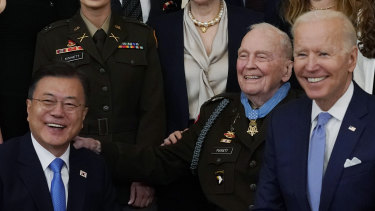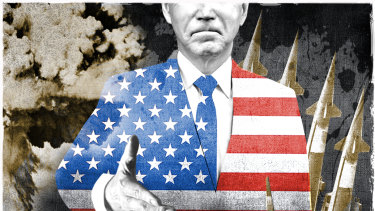In the four months he’s been US President, Joe Biden has held only two face-to-face summits. His choice of leaders to invite to Washington is a clear and deliberate framing for his presidency and for global power politics.
The first summit was with Japan’s Prime Minister Yoshihide Suga. The second was held on the weekend when South Korea’s President Moon Jae-in stepped into the White House.
South Korean President Moon Jae-in and US President Joe Biden presenting a medal to a US veteran of the Korean War on the weekend.Credit:AP
So why Japan and South Korea? They are the two US treaty allies nearest China. In the meantime Biden is keeping China’s President Xi Jinping waiting. Biden is gathering his friends close as he prepares to confront his rival, exactly as he said he’d do on taking the presidency.
“They have an overall goal to become the leading country in the world, the wealthiest country in the world, and the most powerful country in the world,” Biden said of China. “That’s not gonna happen on my watch.”
The US is “not looking for confrontation”, Biden said he’d told Xi by phone, but that “there’ll be steep, steep competition”.
In the interim, Biden created a new coalition of democratic leaders in the region – convening the first summit of the Quad countries of Australia, India, Japan and the US – by video link in March. They committed to a “free and open Indo-Pacific”.
Illustration: Dionne GainCredit:SMH
“We can be sure there will be blowback from both North Korea and China,” an American expert on the Koreas, David Maxwell, wrote for the Nelson Report. To South Korea, he said: “Brace yourselves for some extreme rhetoric and possible economic warfare from China.”
The leaders also promised to step up vaccine co-operation, something else that Moon had wanted. Only about 5 per cent of the South Korean population has been inoculated against COVID-19.
And Moon gave the American leader the support he wanted for the confrontation with Beijing. There was a three-pronged set of joint statements. First was commitment to “respect for international law including freedom of navigation and overflight in the South China Sea and beyond”. Second was to “preserving peace and stability in the Taiwan Strait”. Third was “to promote human rights and rule of law issues”.
And the inevitable question hanging over anything to do with the Korean peninsula – what to do about North Korea? Donald Trump’s love affair with Kim Jong-un was even more strategically useless than it was theatrically outlandish.
Trump’s embrace of Kim was well broadcast. Less well known is that, by the end of Trump’s term, Kim had approximately doubled his nuclear arsenal. A Stanford University expert on the topic, Siegfried Hecker, estimates that North Korea now has some 45 nuclear weapons, and adding perhaps another six every year.
Joe Biden returned US policy to its pre-Trump status quo. Which is about setting up negotiations and possibly offering concessions to Kim in return for dismantling his nuclear program. This approach failed for the 30 years preceding Trump.
And, as The New York Times reported on the weekend: “In private, officials in the Biden administration admit they harbour no illusions that North Korea will ever give up the entirety of its program. Yet, like his predecessors, Mr Biden has made the decision not to officially acknowledge the North as a nuclear state, aides say.”
Why the pretence? The Times quotes a US nuclear expert, former diplomat Robert Einhorn, saying that a formal acknowledgment of North Korea as a nuclear state would “increase interest by South Korea and Japan in acquiring their own nuclear weapons”.
It gets harder and harder to believe in the credibility of the US nuclear umbrella, otherwise known as extended deterrence. That’s the doctrine that says US allies like Australia, Japan and South Korea don’t need our own nukes because America promises to protect us with its. If an enemy state should threaten to fry Australia, the Americans would deter it by threatening nuclear retaliation.
This system was set up at a time when China’s nuclear missiles couldn’t reach the US. Now they can. And at a time when North Korea had no nuclear missiles at all. Now it is able to launch missiles from a submarine and has nuclear warheads to mount on them. Would the US really risk nuclear attack to protect Australia, South Korea or Japan?
And then there’s the Trump factor. Would a future Trump, an erratic nativist “America First” populist, take such a risk? The nuclear umbrella has some big holes in it.
For now, America’s allies are too polite to say so. So, once again, we engage in the pretence that North Korea can be persuaded through negotiation to abandon its nuclear insurance policy, its hard-won nuclear arsenal. It’s the season for the US and its allies to restore relationships post-Trump. Just don’t mention the (nuclear) war.
Peter Hartcher is international editor.
What in the World
A note direct from our foreign correspondents about what’s making headlines around the world. Sign up for our weekly newsletter here.
Most Viewed in World
From our partners
Source: Read Full Article


